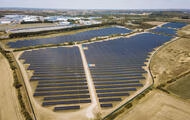How Is JLR Using Solar Power to Transform Its UK Operations?
If you’ve ever wondered how major automakers are tackling sustainability, Jaguar Land Rover (JLR) is offering a pretty compelling answer. At their Gaydon headquarters in the UK, JLR has just unveiled a solar farm so massive, it covers the equivalent of 36 football pitches. That’s not just a flashy headline—it’s a real, boots-on-the-ground commitment to cleaner energy and a more resilient business.
What Does a 26-Hectare Solar Farm Actually Mean for JLR?
Let’s break down the numbers. The new solar installation at Gaydon spans 26 hectares and boasts an 18-megawatt capacity. In plain English? It can generate enough electricity to power about a third of JLR’s entire base at the site. This isn’t just a token gesture. It’s a significant chunk of their energy needs, directly supporting the teams behind design, engineering, and R&D.
But why does this matter? For starters, it means JLR is less reliant on the national grid, which can be unpredictable and subject to price swings. By generating their own power, they’re not just cutting emissions—they’re also insulating themselves from fluctuating energy costs. That’s a win-win for both the environment and the company’s bottom line.
How Does This Fit Into JLR’s Bigger Sustainability Goals?
JLR isn’t stopping at Gaydon. The company has set a target to source at least 30% of its global energy use from on-site renewables. That’s ambitious, but it’s also increasingly necessary as the auto industry faces mounting pressure to decarbonize.
Take their Wolverhampton Electric Propulsion Manufacturing Centre, for example. Soon, it’ll be home to one of the UK’s largest rooftop solar arrays, with over 18,000 panels. Once operational, this setup will generate around 9,500 megawatt-hours of energy each year—enough to meet 40% of the site’s needs. That’s a serious dent in their carbon footprint.
Are Solar Car Ports the Next Big Thing for EV Charging?
Looking ahead, JLR is planning to install 10 megawatts of solar car ports at its Merseyside site next year. These aren’t just your average parking spots—they’ll feature canopies and solar walkways, a concept that’s already popular in sun-drenched countries like Spain. The main goal? To provide clean, on-site energy for electric vehicle charging. As more drivers make the switch to EVs, having a reliable, renewable source of power for charging is going to be essential.
What’s the Real-World Impact of These Projects?
It’s easy to get lost in the numbers, but the impact is tangible. By investing in large-scale solar, JLR is directly reducing its operational emissions. According to Andrea Debbane, JLR’s chief sustainability officer, these steps are “important” not just for hitting net zero targets, but for delivering real value—both today and in the long run.
And JLR isn’t alone. According to the UK’s Department for Business, Energy & Industrial Strategy, renewable energy accounted for 41.4% of the country’s electricity generation in 2022, up from just 6.7% in 2010. The automotive sector is increasingly part of that story, with companies like JLR leading the charge.
Why Should Other Companies Pay Attention?
JLR’s approach offers a blueprint for other manufacturers. It’s not just about ticking a sustainability box—it’s about building resilience, controlling costs, and future-proofing operations. By investing in on-site renewables, companies can navigate energy market volatility, meet regulatory requirements, and appeal to eco-conscious consumers.
Plus, these projects have a ripple effect. They create jobs, spur innovation, and help shift public perception of what’s possible in heavy industry.
The Takeaway: A Brighter, Greener Road Ahead
JLR’s solar initiatives are more than just a headline—they’re a sign of where the industry is headed. By harnessing the power of the sun, the company is cutting emissions, saving money, and setting a new standard for what’s possible in automotive manufacturing. For anyone interested in the future of clean energy and sustainable business, it’s a story worth watching—and maybe even emulating.

